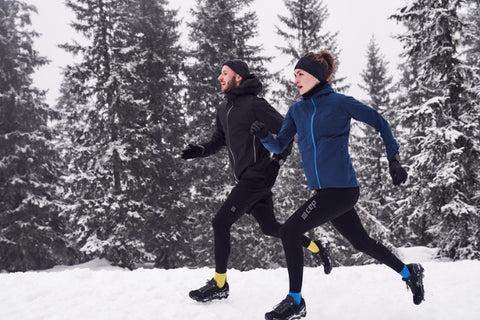How to Stay Safe While Running in Winter


A dedicated runner doesn’t take three months off during winter, and some people consider “treadmill” a swear word. Sound like you? We’ve got some advice for winter running to help you plan for safe, enjoyable training.
3 Tips for Winter Season Running and Training
Survey and Study Your Routes
Planning is key if you’re a winter runner. The weather forecast will dictate your choices in clothing, shoes, route, and distance. With enough preparation, you could run in an ice storm with traction devices on both feet (but we don’t recommend it).
Speaking of ice, a great winter running plan includes surveying a few different routes and watching them closely. Pick a couple trail or gravel road routes if your area is prone to freezing rain or icy snowpack because they’re easier to navigate than on sidewalks or roads. As you run these routes, log the icy patches into memory so you’ll recall them if the route gets covered by new snow. If you haven’t been on a route for a while, consider walking it first with an eye keen for dangerous spots.
You should also be conscious of how much sunlight your area gets. Depending on when you normally run, it might get dark fast enough that you should invest in reflective or illuminated running gear. You need to be able to see where you’re going, and other people need to be able to see you, too.
Dress Right and Cover Your Skin
The forecast obviously helps you pick the right clothing for rain, snow, and freezing temperatures. Moisture-wicking fabrics are your best bet for base layers and socks. Knee-high compression running socks are a great option for warmth and circulation. Avoid cotton clothing if possible because it absorbs moisture and dries slowly leading easily to a chill.
Picking a jacket to match the day’s climate is crucial. Rain or sleet demand a waterproof coat even if it’s not your favorite. Since you warm up as you run, dress for temperatures 10-15 degrees warmer. And don’t forget your extremities. Cover your hands, head, ears, and possibly your face if the windchill is extremely low. Skin freezes in 30 minutes in a windchill of -19. That’s 0 degrees plus a 15-mile-an-hour wind — an average winter day in some states.
Warm Your Muscles First
After planning accordingly, warm your muscles with some pre-run exercise and make sure you’re hydrated. Cold muscles injure easily and cold weather zaps hydration. A 7-minute round of High Impact Interval Training with exercises like jumping jacks, burpees, lunges, and mountain climbers will do the trick. For a more moderate warmup, try a dozen yoga sun salutations or five minutes on a treadmill.
Grab water as you head out on long runs because you may not feel thirsty, but you’ll still lose your hydration through sweat.
Gear Up for Winter Training With CEP Compression
All this planning will pay off hugely by keeping you comfortable and safe on your winter runs. Plus, you can share your safe routes will fellow runners.
If you need help finding cold weather running gear, take a look at our catalog. CEP Compression socks and running tights offer a precision compression profile that promotes better blood flow, increased joint stability, and a number of other benefits. Let us know if you have any questions.



